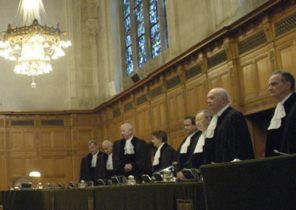In 1969, the American astronomer Vera Rubin (Vera Rubin) was stumped in the course of observation stretched in outer space the galaxy called Andromeda, the closest neighbor of the milky way. In the process of monitoring the spiral arms of stars, which were very carefully measured with the spectral analysis carried out at the National laboratory Kitt Peak (Kitt Peak National Observatory) and in the laboratory of Lowell (Lowell Observatory), both located in Arizona, she found something unusual: I had the impression that the stars on the fringes of this galaxy, are moving in their orbits too fast. So quickly that she began to expect their isolation from Andromeda and care somewhere further into the universe. However, the rotating spiral of the stars remained in their places.
Monitoring the ruby, which she had extended to dozens of other spiral galaxies, has led to a dramatic dilemma: either they have more mass, dark and hidden from observation, but is able to hold the galaxy together with their gravitational fields or gravity somehow works in different parts extended in space galaxy is quite different from what scientists previously believed.
Rubin made an important discovery was not awarded the Nobel prize, but scientists began to search for traces of dark matter in other places around stars and gas clouds, as well as around the largest structures in galaxies throughout the universe. In 1970 astrophysicist Simon white (Simon White) from Cambridge University said that may explain the conglomeration of galaxies using a model in which the majority of matter in the universe is dark, and its number much greater than all the atoms in all the stars in the sky. In the next decade, the white and other experts have continued their research in this direction by modeling the dynamics of the hypothetical particles of dark matter, working with computers, which at that time was not so friendly to users.
However, despite the progress made over the last half a century, no one has been able to directly detect a single particle of dark matter. Every time that dark matter has eluded researchers, as a fleeting shadow in the forest. Every time scientists have tried to detect dark matter particles using a powerful and sensitive experiments in abandoned mines and in the Antarctic, and every time they tried to produce them in accelerators of elementary particles, every time they were empty handed. Some physicists hoped to detect a theoretical type of matter is called “weakly interacting massive particles” (weakly interacting massive particles —WIMP), but these attempts proved fruitless.
As the nomination weakly interacting massive particles got almost no chance, dark matter, apparently, continues to be the most common [in the universe] thing that physics can’t detect. And yet they can’t find her, there is still the probability that she does not exist. But there remains the alternative: instead of a huge amount of hidden matter, some mysterious aspect of gravity can bend space.
The idea that gravity behaves any differently on a large scale [of galaxies], have been relegated to the periphery studies since the heyday of theory, Rubin and white. However, now is the time to consider this opportunity. Scientists and research teams need to directed at finding alternatives to dark matter. Conferences and committees on the distribution of grants should discuss these theories and to devise new experiments. Regardless of who is right, such research alternative options will ultimately help to crystallize the demarcation line between what we know and what we know. Such measures will contribute to the formulation of bold issues, spur the productivity of research, will outline the weaknesses in these theories and will help new thinking to move forward. In addition, it will force us to decide what kind of evidence we need to believe in what we cannot see.
***
We have already passed. In the early 1980s, the years of Israeli physicist Mordechai “Moti” Milgrom (Mordehai ‘Moti’ Milgrom) have called into question the increasingly popular narrative about dark matter. While working at the Institute, located in the South of tel Aviv, he studied the measurements of Rubin and other experts, and then suggested that physics, in fact, did not need to the missing and elusive matter; instead, they mistakenly believed that fully understand how gravity works. Since distant stars and gas clouds move in orbits around galaxies faster than expected, it makes more sense to adjust the standard view of gravity, than to invent a completely new type of matter.
Milgrom suggested that the second Newton’s law of motion (it describes how the gravitational force acting on the object changes depending on acceleration and mass) varies a little depending on the object’s acceleration. Planets like Neptune or Uranus, orbiting around the Sun, or stars moving in orbits close to the center of our galaxy do not feel this distinction. But in remote parts of the milky way the stars will act weaker gravitational force than previously assumed relatively large part of the matter of this galaxy; therefore, the refinement of Newton’s law can provide an explanation for the measured Rubin speeds, it will not be necessary to bring this case dark matter.
Development paradigm based on the idea of the absence of dark matter, has become a major life project Milgrome. First of all, he worked primarily in isolation over its prototheria, which is called Modified Newtonian dynamics (Modified Newtonian Dynamics — MOND). “For many years I was alone,’ he says. But gradually, other scientists began to join me”.
Milgrom himself and several other scholars have focused on rotating galaxies, where the modified Newtonian dynamics accurately describes what was observed by Rubin, and makes it no worse than the theory where there is dark matter. After a while Milgrom and his colleagues have expanded the scope of studies and suggested the existence of a relationship between the speed with which rotates the far side of the galaxy and its total mass minus dark matter. Astronomers Brent Tully (R Brent Tully) and Richard Fisher (Richard Fisher J) just measured and confirmed the existence of the trend, with the explanation which had problems with many theories based on the existence of dark matter.
Despite these advances made by Milgroom modification of Newton’s second law continued to be only an estimate, so his ideas did not fully satisfy the requirements of a full-fledged theory. The situation began to change, when Jacob Bekenstein (Jacob Bekenstein), a colleague Milgrom for work at the Hebrew University of Jerusalem (Hebrew University of Jerusalem), expanded modified Newtonian dynamics in order to show its compliance with the General theory of relativity of albert Einstein, which States that gravity has the ability to reject light rays, and this idea, which was proved only a century ago, during an Eclipse of the sun in 1919, now known as “gravitational lens” (gravitational lensing).
At about this time the American astronomer Edwin Hubble (Edwin Hubble) drew attention to the opinion of his colleagues that a close group of gas clouds are actually more distant galaxies. Based on the discovery of Hubble and other astronomers showed the existence of a larger galactic structures received today called “galactic clusters” (galaxy clusters) that possess the ability to act as a powerful lens and substantially reject light rays. Using formulae based on the predictions of Einstein, we can conclude about the mass of cosmic lenses. Based on such mathematical formulas, many physicists used the gravitational lens as an argument in favor of existence of dark matter. However, Bekenstein showed that General relativity and modified Newtonian dynamics is also able to explain at least some of the measuring lenses.
But even then these ideas were only partially formulated. In fact, Milgrom and Bekenstein didn’t know what kind of physical processes can yield a modified gravitational law.
Modified Newtonian dynamics is largely not enough to the basics, but the situation changed a few years ago, when Dutch physicist Eric specific for (Erik Verlinde) began to develop a theory called “emergent gravity” (emergent gravity), and this was done in order to explain why gravity is changing. According to specific for gravity, including modified Newtonian dynamics appears as a kind of thermodynamic effect related to the increase of entropy or destruction order. His ideas are also based on quantum physics, because it treats space-time and matter within it are derived from the interconnected flow of quantum particles. When space-time is curved, there is gravity, and if a curvature occurs in a certain way, it creates the illusion of the existence of dark matter.
Studies specific for still require further elaboration. For example, it is not clear how modified or arising gravity can be perceived in the structure of the early universe that differs from the relic radiation from the Big Bang. Astrophysics used the space telescopes to record the radiation in incredible detail, but have been unable to find a way to make a model without dark matter, which would not contradict these measurements. “Yet this idea of emerging gravity can not compete,” — says specific for, however, in his opinion, it could become a real alternative to dark matter.
***
In theories of dark matter also made the prediction: if this form of matter exists, many subatomic particles of dark matter have often zipping through our solar system, through the Ground and sometimes even through our own bodies. But, if a huge quantity of dark matter actually exists, enveloping him every galaxy in the universe and while this invisible and intangible, then these elusive little particles, most likely will not interact with normal matter in such a way that all we could see. In this case, the detection of dark matter becomes extremely difficult.
While astrophysics has continued to look carefully into the heavens, physicists studying particles, also tried to shed light on dark matter by using obtaining probable particles in their accelerators, including the Large hadron Collider in Geneva, Switzerland. To create the conditions that existed during the Big Bang, the accelerators of particles colliding at very high speeds, and this is done in order that the bundles of energy has formed new particles. Then these particles must pass through a series of detectors which allow physicists to identify them.
With the help of the Large hadron Collider and its predecessors (including accelerator Laboratory behalf of the Fermi — Fermilab — East of Chicago), scientists were able to detect all predicted 17 particles using a “standard model” of particle physics, including all fundamental forces except gravity. (Scientists have discovered the latest standard particle, the Higgs boson at the Large hadron Collider in 2012).
Because of the successes of physics has gained confidence in his abilities and hoped soon to detect dark matter, Dan Hooper stresses (Dan Hooper), a physicist from Fermilab, the laboratory named Fermi, in his published in 2019 book “On the edge of time” (At the Edge of Time.)
Interest in the dark mother facilitated a number of experiments of a new generation, with which Hooper and his colleagues had hoped to find finally these mysterious particles. Scientists around the world have installed the detectors under the ground, often using abandoned mines, and hoped in this way to detect dark matter particles and to avoid the impact camponeschi noise of cosmic rays and solar particles that will bombard mounted on the surface of the Earth sensors. According to scientists, dark matter particles can silently pass through is made of a xenon detector and leave a mark of their passage in the form of heat. If the experiments will take place as planned, the scientists finally detects particles of dark matter and announce a new era in cosmology and nuclear physics.
However, the experiments yielded no positive results, the initial hope of scientists is not justified. The experiments actually failed to detect a hint of the existence of dark matter, however, allowed to eventually identify what dark matter is. With each new experiment increasing the number of examples of what dark matter is. Physicists began to understand that if dark matter particles exist, they will be very difficult to see. The situation looked almost hopeless in relation to weakly interacting massive particles (WIMP), which were the most popular candidates for dark matter. Scientists have expanded the scope of searches, but found nothing. Some teams continued to hunt for weakly interacting massive particles, but in a few years reached the most insignificant weights when any proposed dark matter particles would interact with the detectors, as is the case with almost imperceptible neutrinos coming from the Sun, as a result, the search for weakly interacting massive particle was, in fact, stopped. “Our work is all finished. We can already see the end of the search for weakly interacting massive particles,” says Peter Graham (Peter Graham), physicist from Stanford University in California.
Although the end of the search of weakly interacting particles is very close, to say the same thing in relation to hunting for dark matter is impossible, according to Graham. Scientists have already begun to pursue other possible particles, especially with axions (axions). If they exist, then there will be billions of times less massive than weakly interacting massive particles, in this case, there may be a huge number, and they can add their mass to the expected mass of dark matter. There are even more exotic candidates — we are talking about the so-called sterile neutrinos (sterile neutrinos) and the tiny primordial black holes; this is the massive compact halo objects (massive compact halo objects).
Some scientists, including Hooper, suggested the existence of hypothetical particles, which are affected by hidden forces. These dark particles, if they exist, will be annihilated, and then decay into other particles that can somehow connect with those already known particles like Higgs bosons. Such a scenario can be considered possible, but so far nobody has been able to detect any hidden particles or forces.
As the search for dark particles lose their intensity, Milgram found that more and more physicists are ready to do modifitsirovannoi gravity. “People are very disappointed, but very annoyed by the fact that dark matter is still not detected, he said. In my opinion, it’s not the best Foundation in order to continue working in the field of modified Newtonian dynamics, but I am pleased that interest is growing.” It cannot yet be said with certainty that this interest will foster more research in the field of modified gravity.
***
Hundreds, if not thousands of astrophysicists, astronomers and nuclear physicists study today, every aspect of dark matter and any possible impact on space, while these works are carried out using the most modern computers, telescopes and particle accelerators. Research in the field of dark matter for several decades has contributed to the decline of studies on the modified gravity, however, this does not necessarily mean that dark matter is much more convincing as a theory. Rather, in the early stages, scientists assumed that there is a natural solution, others agree, and the balance is tilting in their direction.
When viewed from today’s perspective, the dominant position of the dark matter does not seem inevitable. The processes by which scientists develop their theories, influenced by a variety of historical and sociological factors. This view is eloquently presented by Andrew Pickering (Andrew Pickering), honorary philosopher of Exeter (University of Exeter) and the author of the work “Construction of quarks” (Constructing Quarks), which was published 36 years ago, but continues to remain relevant.
It is also important to pay attention to who makes the decision about what phenomena should be studied, what research get large government grants, what are the major experiments get funding, who gets the opportunity to speak at conferences, who is able to work well with the media who are involved in the most well-known programs and receives awards; and who gets appointed to important positions in universities. The various options can sometimes shape the future path of scientific development. And when the choice theorists and experimentalists symbiotic match, says Pickering, it may become an obstacle to the latter-day theory — including the retrofit of gravity — as well as for its adequate perception.
Academic work is particularly effective and direct way to “true”. However, do not despair, says Naomi Oreskes (Naomi Oreskes), a historian of science at Harvard University in Massachusetts and author published in 2019 book “Should we trust science?” (Why Trust Science?). Although individual scientists can make mistakes, have their own values and goals, and sometimes their obsessions, science, however, continues to evolve as a collective endeavour. Researchers can make mistakes, it can take a long time to thoroughly test some of the allegations and to offer the other, and, in addition, it also happens that seemingly promising research program comes to a standstill, but over time scientists gradually come to a common opinion. It usually takes a lot of time, but eventually they understand, from what research areas should be abandoned, and the study of what ideas need to continue and deepen.
As for the rivalry between dark matter and modified gravity, this process is not yet ended. Dark matter is currently on the downlink, but the debate is not over. The stakes are high because the future of cosmology depends on the upcoming elections astrophysicists.
The proponents of modified gravity, including Milgrom and specific for, face serious challenges, and only after the solution of the existing problems they will be able to get a real chance to develop their ideas into a meaningful alternative to dark matter. The biggest obstacle in this regard comes from the beginning of the universe.
Astronomers Anro Penzias (Arno Penzias) and Robert Wilson (Robert Wilson) in the 1960s at first incorrectly interpreted by light interference on their radio telescope as noise, probably due to the fact that pigeons have set up nest and leave droppings. However, the signal was real, and they confirmed his discovery of radio waves relict (relic radio waves), which was formed soon more of the Big Bang. Then, in 1980-e and 1990-e years Soviet scientists and scientists from NASA used their own telescopes RELIKT-1 and Cobe for the detection of extremely small fluctuations in this radiation. John Mather (John Mather) and George Smoot (George Smoot) of physics, head of the Cobe research program, received in 2006 the Nobel prize in physics for the measurement of these minor fluctuations in the radiation that indicate an early difference in the intensity, which determine where the matter in the universe was concentrated where formed galactic structures.
Followers of Mather and Smoot today measure the fluctuations in the relic radiation with very high accuracy, and any successful theory must provide an explanation. Studying dark matter face already showed that their theory is able to explain all these minor variations, however, modified in, or arising gravity could not stand this crucial test yet. Bekenstein died in 2015, but his followers are still trying to make it a modified theory of gravity corresponding to at least some of the conducted measurements. It would be a significant leap forward and make a compelling argument for those who are skeptical about the modified gravity, however, this is a very serious problem which has yet to be addressed.
From all the obtained data, the information about these minor fluctuations is the most persuasive. Dark matter is clearly winning. It took decades of work from hundreds of scientists that support the theory of dark matter, as well as a large investment in their research programs in order to develop models to explain the measurements. A modified version of emergent gravity with its more modest funding levels, remains far behind, but this does not mean that we should abandon those concepts. “In my opinion, it is unlikely that the resulting gravity is responsible for the phenomena that we associate with dark matter, says Hooper. — However, this does not mean that gravity does not occur and it is not necessary to study”.
In addition, the proponents of dark matter, including white and Hooper have their own serious problems. Giant galaxies, including our own, typically have a small number of galactic companions that revolve around them like satellites. If the proponents of dark matter are right, every galaxy must be embedded in a huge clump of dark matter, since dark matter particles and galactic stars are supposed to attract each other with the same gravitational forces. However, recent data from computer modeling, was developed by white and his colleagues, reveal a significant discrepancy with the observations of astronomers: they predict the existence of much more matter than was assumed on the basis of scant data about discovered until the galactic satellites. Physicists have come up with a very distinctive name — “missing satellites problem” (missing satellites problem), because the reality, apparently, does not meet the expectations of these theorists.
In the broader cosmic scale of astrophysics is trying to explain recently installed a striking discrepancy: it is that today the universe is apparently expanding much faster than it happened during her childhood. Physics believed that the scale of growth (called the Hubble constant) are the same everywhere, but today they have to explain discrepancies. As proponents of the dark matter can not explain this mysterious phenomenon, then, according to specific for arising of gravity is likely to propose a way forward.
Specific for, Milgrom, and their colleagues still represent a small minority, however, the cosmology will benefit in the case that their ranks will increase quantitatively. At the recent conference specific for noticed a significant shift towards the recognition. “I felt that there was more communication and more willing to discuss alternatives than it was a few years ago,” he says.
In addition to theoretical work, physicists expect the large size and more powerful in characteristics of the telescopes and carrying out experiments, is able to give relevant results. We are talking in particular about the Large SYNOPTIC survey telescope (Large Synoptic Survey Telescope), which is constructed in the dry mountainous area in the North of Chile. This year, scientists have called it an Observatory of Faith ruby, and the first data it will receive this year. Inspired by the work of Rubin, the researchers will try to look more broadly and further into the heavens, capturing the light from billions of galaxies. If they are not tied to any framework, their research may shed light on dark matter and dark gravity. The memory of ruby will continue to promote healthy discussions about the enormous hidden universe, for further study which we seek.
Ramin Skibba and astrophysicist, who became a science educator, lives and works in San Diego.







